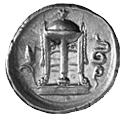Ancient coins


Greeks, Thrakien /Maroneia Stater about 346–347 (left); Greeks, Attika/Athen Tetrachdrachme about 440 (right)
The coin, that small and handy piece of precious metal with a portrayal was created in the 7th century BC in southwest Asia Minor. The coin depiction was, similar to the hallmarks on articles of precious metal still in use today, a guarantee stamp for weight and fineness. Within a century, this epochal economic innovation spread across the whole Greek world and its colonies.
Today's collector is fascinated by the multiple themes and depictions. This is due to the autonomy of the Greek city-states that found its expression on their coin depictions. The plants, fruits, animals, cult objects, river gods and nymphs must be seen in relation to the great Olympic deities or local cults. The message of the coins in the 6th-4th century BC is of a religious source. Portraits of living rulers on coins, as later come in coinage of 2000 years, begins in the course of the ruler cult formed by the successors of Alexander the Great.



Greeks, Lukanien/Metapont Nomos 4th century BC (left); Greeks, Bruttium/Kroton Nomos 5th/4th century BC (middle); Celtics, Britannien Goldstater about 40/20 BC/Horse (right)
In the last two centuries BC , the Celtic tribes in the West (Gaiul, Britain) and East (Danube area) begin their own coinage and change the classic models in a fantastic way.
Rome and the middle Italian countryside developed a coinage in the 4th century BC based on a system of cast copper. Coinage struck in gold, silver and bronze develops only after direct contact with the Greek cities in southern Italy and the Punic Wars in the 3rd century BC.


roman empire, Traianus 98–117, Sesterz 106 (left); roman emipre, Antoninus Pius 138–161, Aureus 152/53 (right)
The coin series of the Roman Republic have been called a picture book of Roman history: the myth of the city's foundation, incidents from the city's history as well as realistic portraits of the "imperators" of the tome of the Civil Wars.

Byzanz, Solidus from Justinianus II, about 697/92
The coins of the Roman Empire fascinate most collectors through the portraits of the emperors and their wives. But the reverses too open us interesting areas of collecting: historical events, imperial propaganda, buildings and monuments. The coins of the later Empire from Diocletian on lose the distinct portraits of the rulers. The emperor as a type and symbol of might is shown and thus leads to the 1000 years of Byzantine coinage that was copied in many ways by the Orient and the Occident in the Middle Ages.